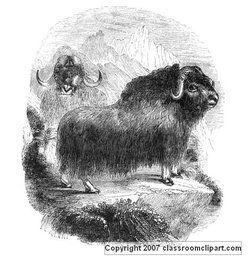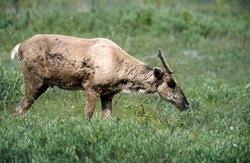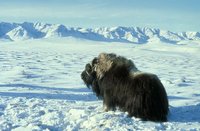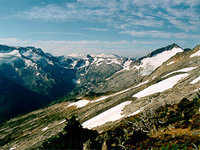Tundra
|
|
In physical geography, tundra is an area where the tree growth is hindered by low temperatures and short growing seasons. There are three types of tundra: Arctic tundra, Antarctic tundra, and alpine tundra. In all of these types, the dominant vegetation is grasses, mosses, and lichens. Trees grow in some of the tundra. The ecotone (or ecological boundary region) between the tundra and the forest is known as the tree-line or timberline.

See also: Fellfields
| Contents |
Arctic tundra
Arctic tundra occurs in the far Northern Hemisphere, north of the taiga belt. The word "tundra" usually refers only to the areas where the subsoil is permafrost, which means permanently frozen soil. (It may also refer to the treeless plain in general, so that northern Lapland would be included.) Permafrost tundra includes vast areas of northern Russia and Canada. The polar tundra is home to several peoples who are mostly nomadic reindeer herders, such as the Nganasan and Nenets in the permafrost area (and the Sami in Lapland).
The arctic tundra is a vast area of stark landscape, which is frozen for much of the year. The soil there is frozen from 25-90 cm down, and so it is impossible for trees to grow. Instead, bare and sometimes rocky land can only support low growing plants such as mosses, heaths and lichen. There are two main seasons – winter and summer in the polar Tundra areas. During the winter, it is very cold and dark, with the average temperature around -28 °C, sometimes dipping as low as -70 °C. In the summer, temperatures rise and the top layer of the permafrost melts, leaving the ground very soggy. The tundra is covered in marshes, lakes, bogs and streams. Generally temperatures during the summer rise to about 12 °C, but can often drop to 3°. Arctic tundras are sometimes the subject of habitat conservation programs; in Canada and Russia many of these areas ae protected through a national Biodiversity Action Plan.
The tundra is a very windy area, with winds blowing upwards of 48–97 km/h (30-60 miles an hour). However in terms of precipitation, it is desert-like, with only about 150–250 mm (6–10 inches) falling a year (mostly of snow). During the summer, the permafrost thaws just enough to let plants grow and reproduce, but because the ground below this is frozen, the water cannot sink any lower, and so the water forms the lakes and marshes found during the summer months.
The biodiversity of the tundras is low: there are 1700 species of flora and only 48 land mammals that can be found, although thousands of insects and plants migrate there each year for the marshes. There are also a few fish species such as the flat fish. There are few species with large populations. Notable animals in the arctic tundra include caribou (reindeer), musk ox, arctic hare, arctic fox, snowy owl, lemmings, and polar bears (only the extreme north).
Due to the harsh climate of the arctic tundra, regions of this kind have seen little human activity, even though they are sometimes rich in natural resources such as oil and uranium. In recent times this has begun to change in Alaska, Russia, and some other parts of the world.
A severe threat to the tundras, specifically the permafrost, is global warming. Permafrost is essentially a frozen bog; in the summer, only its surface layer melts. The melting of the permafrost in a given area on human time scales (decades or centuries) could radically change which species can survive there.
Another concern is that about one third of the world's soil-bound carbon is in taiga and tundra areas. When the permafrost melts, it releases carbon, in the form of carbon dioxide, a greenhouse gas. The effect has been observed in Alaska. In the 1970s, the tundra was a carbon sink, but today, it is a carbon source.
Antarctic tundra
Antarctic tundra occurs on Antarctica and on several antarctic and subantarctic islands, including South Georgia and the South Sandwich Islands and the Kerguelen Islands. Antarctica is mostly too cold and dry to support vegetation, and most of the continent is covered by ice fields. However, some portions of the continent, particularly the Antarctic Peninsula, have areas of rocky soil that support tundra. Its flora presently consists of around 300-400 lichens, 100 mosses, 25 liverworts, around 700 terrestrial and aquatic algae species, which live on the areas of exposed rock and soil around the shore of the continent. Antarctica's two flowering plant species, the Antarctic hair grass and Antarctic pearlwort, are found on the northern and western parts of the Antarctic Peninsula.
In contrast with the arctic tundra, the Antarctic tundra lacks a large mammal fauna, mostly due to its physical isolation from the other continents. Sea mammals and sea birds, including seals, penguins, inhabit areas near the shore, and some small mammals, like rabbits and cats, have been introduced by humans to some of the subantarctic islands.
The flora and fauna of Antarctica and the Antarctic Islands (south of 60° south latitude) are protected by the Antarctic Treaty.
Alpine tundra
Alpine tundra occurs at high enough altitude at any latitude on Earth. Alpine tundra also lacks trees, but does not usually have permafrost, and alpine soils are generally better drained than permafrost soils. Alpine tundra transitions to subalpine forests below the tree-line; stunted forests occurring at the forest-tundra ecotone are known as Krummholz.
Notable animals in the alpine tundra include, Kea parrots, marmots, Mountain goats, and pika.
Alpine tundra does not map directly to specific WWF ecoregions. Portions of Montane grasslands and shrublands ecoregions include alpine tundra. The alpine tundra also has elks,marmots, mountain goats, pikas, and sheep.
See also: Alpine climate
External links
- Tundra biome information (http://www.ucmp.berkeley.edu/glossary/gloss5/biome/tundra.html) from the University of California
- WWF Tundra Ecoregions (http://www.panda.org/about_wwf/where_we_work/ecoregions/about/habitat_types/selecting_terrestrial_ecoregions/habitat11.cfm)
- The Arctic biome at Classroom of the Future (http://www.cotf.edu/ete/modules/msese/earthsysflr/tundra.html)
External link
- Tundra biome information from the University of California (http://www.ucmp.berkeley.edu/glossary/gloss5/biome/tundra.html)
- Arctic tundra biome information from the WWF (http://www.panda.org/about_wwf/where_we_work/ecoregions/global200/pages/habitat/habitat11.htm)
- Alpine tundra information from the WWF (http://www.panda.org/about_wwf/where_we_work/ecoregions/global200/pages/habitat/habitat10.htm)
- The Arctic biome at Classroom of the Future (http://www.cotf.edu/ete/modules/msese/earthsysflr/tundra.html)



